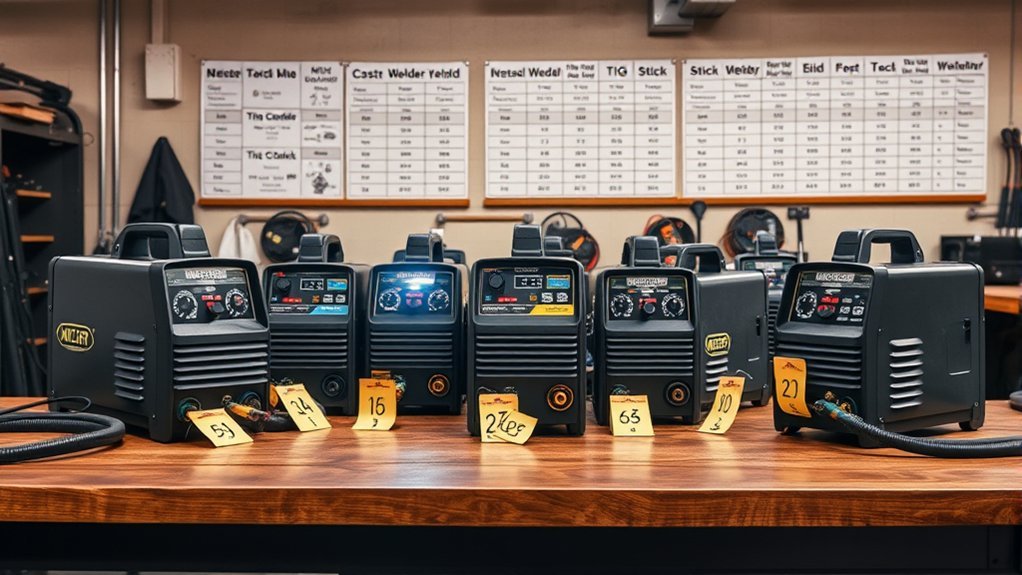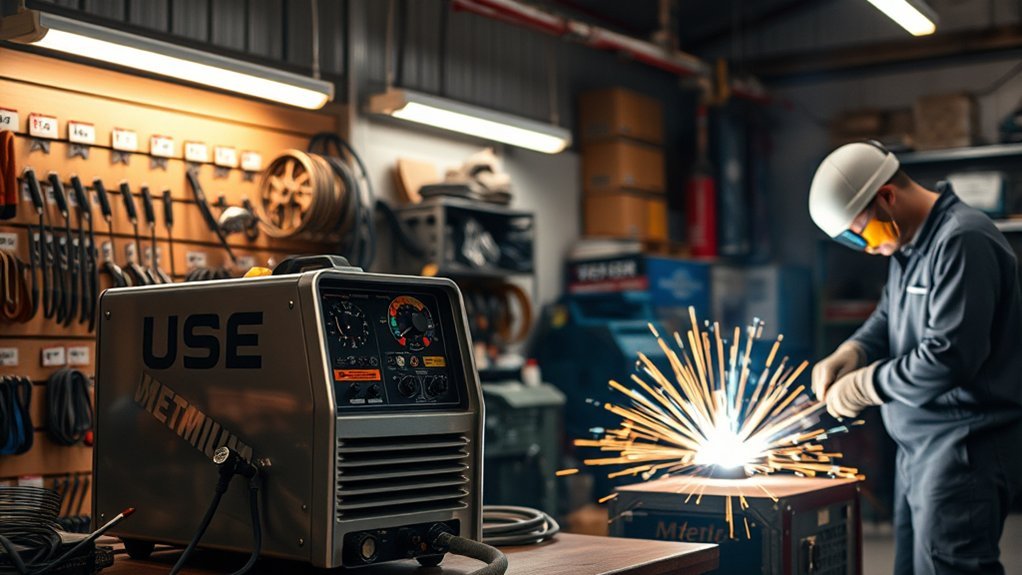Welding equipment costs can range markedly based on the type and brand. Basic MIG welders start around $300, while TIG welders can range from $500 to over $5,000. For multiprocess machines, you might pay anywhere from $1,000 to more than $10,000. Factors like power output, brand reputation, and additional features can also impact pricing. Understanding ongoing costs and equipment maintenance is vital for budgeting effectively. There’s much more to reflect on when selecting the right welder, so keep exploring!
Overview of Welding Equipment Types

Welding equipment encompasses various types tailored to meet specific applications and user preferences.
MIG welders, favored by beginners, are user-friendly and typically range from $300 to $1,000.
MIG welders are ideal for beginners, offering ease of use and pricing between $300 and $1,000.
For high-precision work, TIG welders excel, costing between $500 and $2,500 for basic setups, while advanced models can exceed $5,000.
If you need a cost-efficient solution, Stick welders start around $100 and are ideal for outdoor or heavy-duty projects.
Multiprocess welders offer versatility by accommodating multiple welding techniques but come at a premium, often ranging from $1,000 to over $10,000.
Proper equipment maintenance is essential for longevity and performance, ensuring your investment serves you well across various projects.
Cost Breakdown and Comparison of Different Types of Welders

When considering the costs associated with various types of welders, you’ll find that each category offers distinct advantages and price points tailored to specific needs.
MIG welders typically range from $300 to $1,000, ideal for beginners and professionals alike, while TIG welders, known for their precision, can cost between $500 and over $5,000, depending on advanced features for intricate welding techniques.
Stick welders are the most budget-friendly, priced from $100 to $1,000. For versatility, multiprocess welders that handle MIG, TIG, and Stick welding range from $1,000 to over $10,000.
Remember that machine maintenance and brand reputation can greatly impact both initial costs and long-term expenses, so choose wisely to suit your welding projects.
Factors Affecting Welding Equipment Costs

Understanding the costs associated with welding equipment requires a closer look at several key factors that influence pricing.
First, the power output considerably impacts costs; higher amperage machines generally command higher prices due to their enhanced capabilities.
Energy efficiency also plays an essential role, as welders with advanced technology may have a higher initial cost but can lead to long-term savings.
Additional features like digital controls and automation can raise prices, so it’s important to evaluate the benefits against costs.
Brand reputation affects pricing too; established brands often charge more due to perceived reliability.
Finally, consider equipment resale value, as investing in quality equipment can yield better returns when it’s time to upgrade or sell.
Ongoing Costs and Considerations When Purchasing Welding Equipment

While selecting welding equipment, it’s vital to take into account ongoing costs that extend beyond the initial purchase price. These include ongoing maintenance, which can vary based on the quality of the equipment. Investing in reputable brands may cost more upfront but often results in lower long-term expenses due to durability.
Additionally, consumable expenses, such as electrodes and filler wire, can greatly impact your budget, so plan accordingly. Operator training is another important factor; it can minimize maintenance costs and prevent damage, ultimately saving you money.
Finally, consider energy efficiency and repair costs when evaluating your options, as these factors can influence productivity and reduce wasted materials, further affecting your ongoing costs.
Popular Welding Machines

When choosing a welding machine, you’ll find several options tailored to different needs.
The Miller Millermatic 211 PRO MIG Welder stands out for its user-friendly design, while the Razorweld RazorArc 200di offers multi-process capabilities for a variety of tasks.
If precision is key for your projects, the Razorweld RazorTig 200 AC/DC will deliver exceptional results, especially on aluminum and stainless steel.
Top MIG Welders
MIG welders are essential tools for both hobbyists and professionals, offering a range of options to suit various applications and budgets.
The Miller Millermatic 211 PRO MIG Welder is a favorite for its ease of use and versatility, priced around $700 to $800.
If you need a versatile machine, consider the MIG-250 Multi-process MIG Welder, which handles different materials for approximately $1,200 to $1,500.
For multifunctionality, the SD-4050 PRO 10-in-1 Aluminum Welder & Cutter performs both MIG welding and cutting for about $1,000.
Budget-conscious users may opt for the MIG-140S Gasless 2 in 1 MIG Welder, ideal for light-duty projects at around $300.
Best TIG Options
TIG welders stand out for their precision and ability to handle thin materials like aluminum and stainless steel, making them essential for intricate projects.
If you’re considering TIG welding, the Razorweld RazorTig 200 AC/DC TIG/Stick Welder is a fantastic option. This machine combines versatility and reliability, catering to various welding tasks at a competitive price.
With advanced models often featuring digital controls and increased power output, you’ll notice significant performance enhancements, albeit at a higher cost.
Popular brands like Miller and Razorweld are well-regarded for their quality, offering machines that fit both professional and hobbyist needs.
Prices for TIG welding machines range from about $500 for basic setups to over $5,000 for advanced models, reflecting their capabilities.
Versatile Multi-Process Machines
Versatile multi-process machines are a game changer for welders, offering the ability to perform TIG, MIG, Stick, and sometimes Plasma welding within a single unit.
These machines provide significant multi-process benefits, allowing you to switch between welding types effortlessly, which is ideal for professionals needing user flexibility in various tasks.
Prices typically range from $1,000 to over $10,000, influenced by features and brand reputation.
Many models, like the Razorweld 160di and Miller XMT 400, come with advanced digital controls and higher power outputs, enhancing performance and efficiency.
Investing in a multi-process welder can be cost-effective, as it eliminates the need for multiple machines, streamlining your workflow and saving you valuable workspace and money.
Safety Gear and Welding Equipment
When you plunge into welding, investing in safety gear and protective equipment is non-negotiable, as it safeguards you from the numerous hazards present in the workspace. Compliance with safety regulations and protective standards is essential to minimize health impacts. Proper gear maintenance is vital to guarantee your equipment remains effective.
| Gear Type | Average Cost | Purpose |
|---|---|---|
| Tillman Cowhide Gloves | $13.24 | Protects hands from heat and sparks |
| StarLite Safety Glasses | $1.75 | Shields eyes from harmful light |
| Fire-Resistant Jacket | $23.05 | Protects body from heat and flames |
Investing in quality safety gear not only adheres to regulations but also enhances your overall welding experience.
Tips for Choosing the Right Welder on a Budget
How do you choose the right welder without breaking the bank? Start with a basic model, as entry-level welders typically range from $100 to $1,500, providing essential features for beginners.
Consider pre-owned equipment; reputable stores often offer inspected used welders at discounted prices, giving you quality options within your budget.
Watch for seasonal discounts and promotions; these can greatly lower costs during holidays or special events.
Look for package deals that include consumables and safety gear to maximize value while minimizing overall expenditure.
Finally, research warranty policies; a solid warranty guarantees protection and support for your investment, making it a wise financial choice in the long run.
Choose wisely, and you’ll find budget-friendly options that meet your welding needs.
Frequently Asked Questions
What Brands Are Considered the Best for Welding Equipment?
When selecting welding equipment, you can’t go wrong with Miller Electric and Lincoln Electric. Both brands offer reliable, high-quality products that cater to various welding needs, ensuring you get the best performance and durability.
Can I Rent Welding Equipment Instead of Buying?
Yes, you can rent welding equipment instead of buying. Welding rental offers flexibility and cost-efficiency, allowing you to access high-quality tools without the upfront investment, while still enjoying the benefits of advanced technology for your projects.
What Is the Lifespan of Welding Equipment?
Welding equipment generally lasts 5 to 10 years, depending on usage and maintenance. Factors like durability, environmental conditions, and frequency of use greatly influence the lifespan, so regular care can extend its functional years considerably.
Are There Financing Options for Purchasing Welders?
Yes, you can explore various financing plans and equipment leasing options for purchasing welders. Many suppliers offer flexible payment terms, allowing you to acquire necessary equipment without the burden of upfront costs. Consider your needs and budget carefully.
How Do I Maintain My Welding Equipment?
To maintain your welding equipment, regularly inspect connections, clean welding tips with appropriate techniques, and lubricate moving parts. Following these welding maintenance tips guarantees peak performance and longevity, preventing costly repairs and downtime in your projects.
Conclusion
In the end, deciding on welding equipment is like choosing a spouse—go for the shiny model, and you might just end up broke! With costs varying from a couple hundred to several thousand, it pays to weigh your options. Sure, you want the latest tech, but remember, your budget is a loyal companion, too. So, pick wisely, or you might find yourself welding more than just metal—like your financial future!


